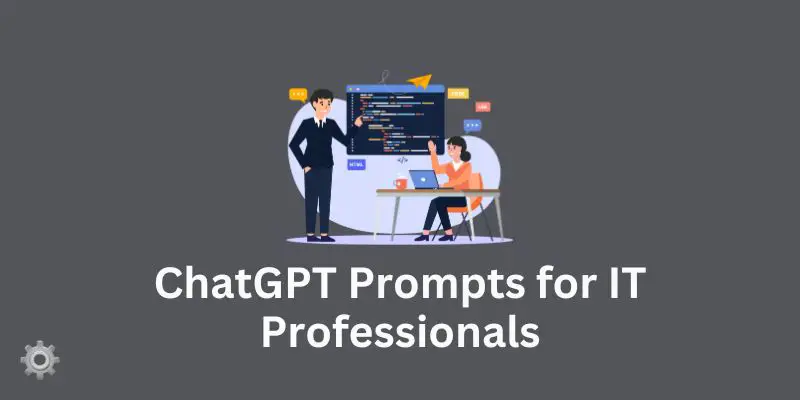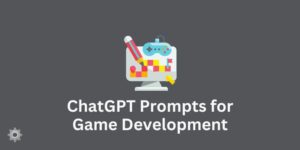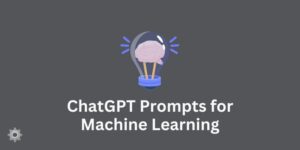In the evolving world of information technology (IT), continuous learning is essential to stay ahead.
Whether you’re a seasoned IT professional or just starting your career, the AI-powered ChatGPT can be an excellent resource for enhancing your knowledge.
This article provides 100 valuable ChatGPT prompts designed to enrich your understanding of different IT domains.
Also read: ChatGPT Prompts for Machine Learning
Essential IT Basics: 20 Prompts
Information technology is a broad field, and having a firm grasp on its fundamental concepts can create a solid foundation for further learning.
Here are 20 prompts that can help you review and explore basic IT concepts.
- “What are the fundamental components of a computer system?”
- “Explain the concept of binary code.”
- “What is the role of an operating system in a computer?”
- “Describe the difference between hardware and software.”
- “What are the various types of software?”
- “What are the essential IT terminologies every professional should know?”
- “How does the internet work?”
- “What are the differences between RAM and ROM?”
- “What is the role of a CPU in a computer system?”
- “Describe the process of booting a computer.”
- “What are input and output devices in a computer?”
- “What is the concept of file systems?”
- “Describe the difference between analog and digital signals.”
- “Explain the different types of network topologies.”
- “What are the layers of the OSI model?”
- “What is the role of IP addressing in networking?”
- “Describe the concepts of client-server and peer-to-peer networking.”
- “What is the function of a router?”
- “What is the importance of firewalls in IT?”
- “How does email communication work?”
Programming and Coding: 20 Prompts
Programming and coding skills are vital for IT professionals, regardless of their specialties. The following 20 prompts can help you understand and improve your programming knowledge.
- “What are the basic concepts of programming?”
- “Explain the difference between high-level and low-level programming languages.”
- “Describe the concepts of object-oriented programming.”
- “What are the principles of functional programming?”
- “What is the role of variables in programming?”
- “Explain the concept of data structures.”
- “What are the different types of algorithms in programming?”
- “What is the role of loops in programming?”
- “Explain the concept of recursion in programming.”
- “How does error handling work in programming?”
- “What is the importance of testing in programming?”
- “Describe the concept of version control in software development.”
- “What are the benefits of pair programming?”
- “Explain the Agile methodology in software development.”
- “What is the importance of code readability and documentation?”
- “Describe the principles of software design patterns.”
- “How do APIs work in programming?”
- “What are the different types of databases in programming?”
- “Explain the concept of SQL in database management.”
- “What are the principles of concurrent programming?”
Cybersecurity: 20 Prompts
Cybersecurity is a crucial aspect of IT, especially given the increasing threat of cyber attacks. Use these 20 prompts to explore essential concepts of cybersecurity.
- “What are the fundamental principles of cybersecurity?”
- “Explain the concept of encryption in cybersecurity.”
- “What are the different types of cyber threats?”
- “Describe the process of risk assessment in cybersecurity.”
- “What are the principles of secure coding?”
- “Explain the concept of ethical hacking.”
- “What is the importance of password policies in cybersecurity?”
- “Describe the role of a firewall in network security.”
- “What is a VPN, and how does it contribute to cybersecurity?”
- “Explain the concept of two-factor authentication.”
- “What is the role of intrusion detection systems in cybersecurity?”
- “Describe the principles of digital forensics.”
- “What is the importance of regular software updates in cybersecurity?”
- “Explain the concept of a secure socket layer (SSL).”
- “What is the role of an antivirus in cybersecurity?”
- “Describe the process of a cybersecurity audit.”
- “What are the common signs of a phishing attack?”
- “Explain the concept of a DDoS attack.”
- “What are the steps to respond to a data breach?”
- “What is the importance of user awareness in cybersecurity?”
Network and Systems Administration: 20 Prompts
Network and systems administration is a fundamental aspect of IT, requiring specialized knowledge and skills. The following prompts can enhance your understanding of this field.
- “What are the roles and responsibilities of a systems administrator?”
- “Explain the concept of a domain controller.”
- “What are the principles of server management?”
- “Describe the concept of virtualization in systems administration.”
- “What are the different types of server operating systems?”
- “Explain the process of network troubleshooting.”
- “What is the role of DNS in network administration?”
- “Describe the concept of load balancing in network management.”
- “What are the principles of network optimization?”
- “Explain the concept of VLAN.”
- “What is the role of subnetting in network administration?”
- “Describe the process of patch management in systems administration.”
- “What are the principles of backup and disaster recovery?”
- “Explain the concept of RAID in data storage.”
- “What is the importance of monitoring in network and systems administration?”
- “Describe the process of capacity planning in systems administration.”
- “What are the different types of network protocols?”
- “Explain the concept of remote desktop administration.”
- “What is the role of Active Directory in systems administration?”
- “What are the best practices for network and systems administration?”
Cloud Computing and Data Management: 20 Prompts
Cloud computing and data management have revolutionized the way IT operates. Use these prompts to explore these significant areas of IT.
- “What are the fundamental concepts of cloud computing?”
- “Explain the difference between public, private, and hybrid clouds.”
- “What are the benefits and challenges of cloud computing?”
- “Describe the role of virtualization in cloud computing.”
- “What is the concept of Infrastructure as a Service (IaaS)?”
- “Explain the principle of Platform as a Service (PaaS).”
- “What is the role of Software as a Service (SaaS) in cloud computing?”
- “Describe the process of data migration to the cloud.”
- “What are the principles of cloud security?”
- “Explain the concept of cloud storage.”
- “What is big data and how is it managed?”
- “Describe the process of data warehousing.”
- “What is the role of data mining in IT?”
- “Explain the concept of business intelligence.”
- “What is the importance of data integrity?”
- “Describe the process of data backup and recovery.”
- “What is the role of data governance in IT?”
- “Explain the concept of data privacy.”
- “What are the principles of data analytics in IT?”
- “What is the future of cloud computing and data management?”
Conclusion
From basic IT principles to complex concepts of cloud computing and data management, these 100 prompts provide a comprehensive overview of different domains within IT.




